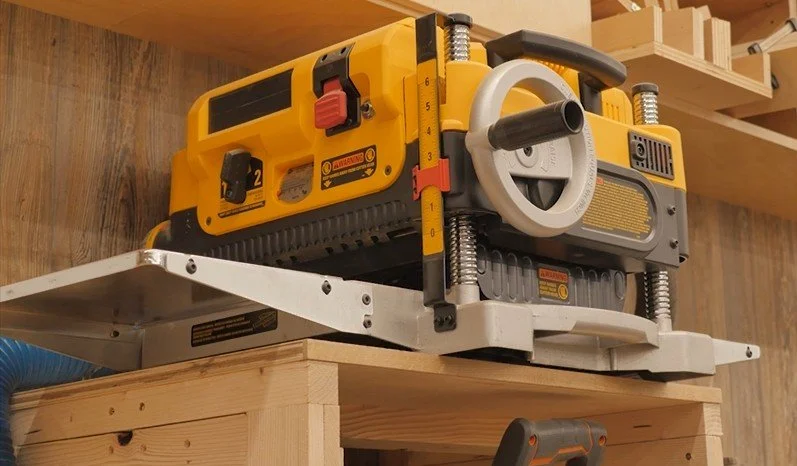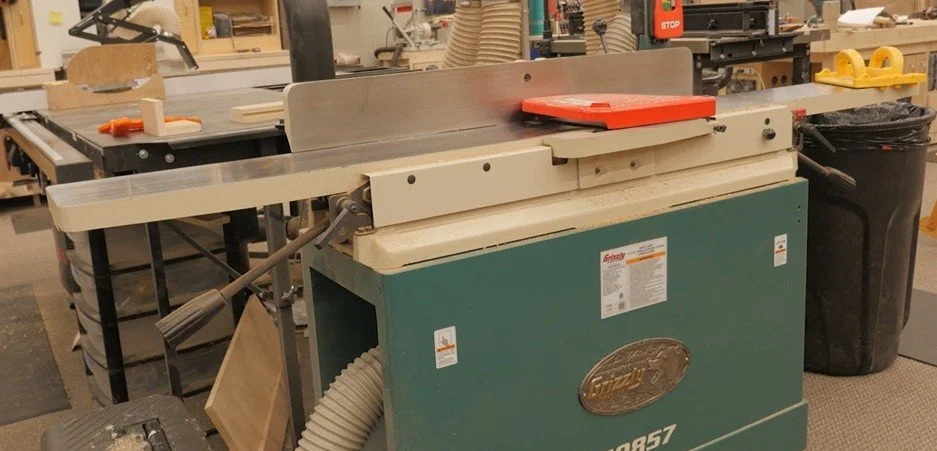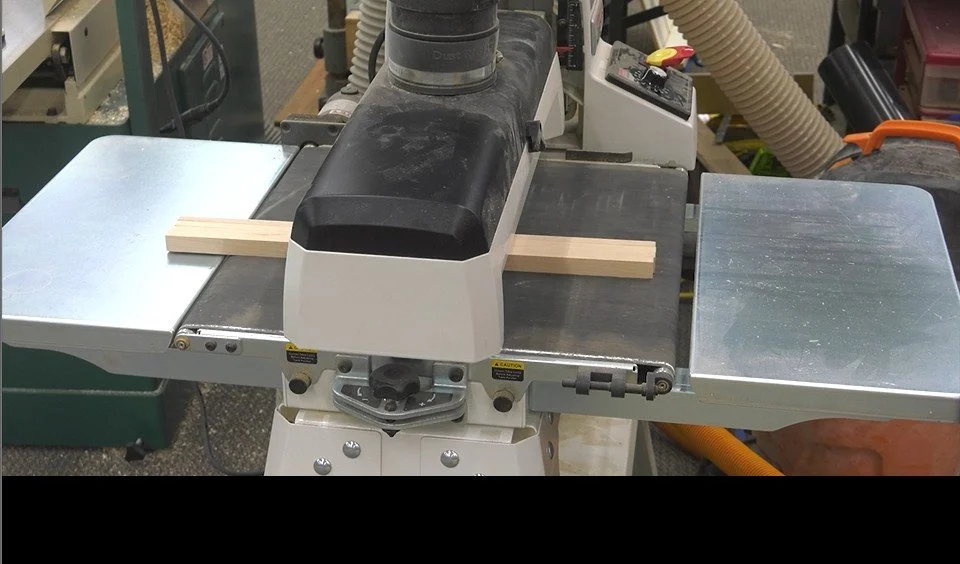JOINTER VS PLANER VS SANDER - WHERE SHOULD YOU START?
When I first started woodworking, there was no way I could afford a jointer and a planer, let alone a drum sander. I knew that each of those machines would be useful, but since I had little experience with any of them, I had no idea which one to buy first, which to get next, or if I even needed all three of them at all.
YouTube wasn’t a thing back then, but today I see a lot of misinformation on this subject. Some people don’t seem to understand the purpose of each machine, while others show some really sketchy ways to get by without them, using other tools.
Let’s take a few minutes to sort this out.
The Role of a Jointer, Planer, and Drum Sander
A jointer, a planer, and a drum sander are all primarily milling machines designed to get your boards flat, straight, square, and to the thickness you need for your projects.
Does this scenario sound familiar?
When you first start out in the craft, you might go to Home Depot and buy some 3/4-inch pine boards. You cut them up and nail them together with little thought about milling because, if a board looks pretty straight when you sight down its length, that’s good enough for you at that level. Pine is soft enough that you can usually force out a slight cup or bow with clamps.
Then you start using hardwood, and you find that it’s more difficult to force that stuff flat. As you begin cutting more joinery, like dados, rabbets, or perhaps the odd finger joint, you discover that even a slight cup in a board can make things very difficult.
After you’ve been frustrated for a while, you become really choosy when picking out your boards. They have to be perfect. That means getting the expensive ones they wrap in plastic. But when you get those home, unwrap them, and start cutting them into project parts, you realize that the next day they aren’t flat anymore. The humidity in your shop was different from the factory where they wrapped those boards in plastic, and now you’re back to forcing them flat with clamps and messing up your joinery.
That’s when many folks first start thinking about a jointer or a planer. They imagine buying less expensive rough-sawn lumber and flattening it themselves in their own shops so it won’t cup on them.
Which Should You Buy First?
Typically, many folks buy a planer first because they’re easier to find and less expensive than a jointer. Besides, they reason that in the old days, folks used to make boards flat with hand planes, so an electric planer should do the trick, right?
Wrong. This is not a "planer," it’s a "thickness planer." It’s not meant to flatten boards—it’s meant to change their thickness. If you put a cupped board in a planer, the rollers will force it flat, but it will pop right back to cupped again when it comes out the other side. You’ll be wasting your time.
Now, I say this with the caveat that there are ways to use a thickness planer to flatten a cupped or slightly warped board. It involves sleds and shims, and it can be done. But it’s a big pain if you have to do several boards for a whole project. We’ll revisit that idea shortly.
Because they’re more expensive, the jointer is rarely the first milling machine people buy. But once they learn the limitations of their planer, they have a change of heart.
Jointer vs. Planer: The Key Differences
While a planer is a thicknessing tool, a jointer is a straightening and flattening tool. Its purpose is to get one face of your board flat and one edge square to that flat face. That’s it. One edge and one face.
You could try to use a jointer to make the second face flat and the second edge straight, but you’ll end up with edges and faces that aren’t parallel to each other. Rather than a rectangle, your board will be a trapezoid.
A jointer can only effectively flatten one face and straighten one side, so it is used in conjunction with a planer and a table saw.
When you run the board through the planer with the newly flat-jointed face down, the cutterhead will shave the remaining rough surface parallel to the flat-jointed one. Additional passes will bring the board down to the final thickness you need for the project.
Then, you can run the straight-jointed edge against your table saw’s fence, ripping the remaining rough edge straight and parallel to the jointed one.
Assuming your tools are all properly set up, you will now have a straight, flat board with all surfaces parallel and square, and at the precise thickness you require. Straight, flat stock will make your craft much more enjoyable and your projects far more impressive.
But as I said, that’s a three-machine process: a jointer, a planer, and a table saw. They all work together. Does that mean you must save up to buy both a jointer and a planer at the same time? In an ideal world, yes.
But we don’t live in an ideal world. A jointer and a planer can represent a big chunk of change, and not everybody can swing it. So, if you had to buy just one for now, which should you buy?
Planer First, Then Jointer
The thickness planer. As I just explained, a jointer is not that useful on its own. It must be used in conjunction with a planer and a table saw. A planer, on the other hand, can at least be used to make boards thinner, if not flatter. And that’s pretty useful.
There are also some clever ways to flatten short boards in a planer using sleds. I’ve even successfully flattened a slightly cupped hardwood board by taking very light passes so the rollers won’t affect it much.
These aren’t ideal circumstances, but if you’re a weekend woodworker who doesn’t go through a lot of wood, it sure beats working with off-the-shelf stock that’s not straight or flat.
Where Does a Drum Sander Fit In?
Now, where does a drum sander come in? Some folks think this is just a machine for making surfaces smooth. But just as a planer is better called a thickness planer, a drum sander is better called a thickness sander.
If you work with very thin workpieces, a thickness sander may be a better option because most planers can only go down to 3/16 or 1/8 inch at most, and they can shatter your thin stock if the grain isn’t just right.
A planer will also struggle with figured grain. Upgrading to a helical cutterhead will help a great deal, but a drum sander will not tear out even the most delicate grain.
Few weekend woodworkers use really thin stock or highly figured grain. But many small workshops make end-grain cutting boards. If you’ve ever tried to feed one of those through a planer and had it explode, you know how sketchy that can be. A drum sander is a much more effective and safer tool for end-grain surfaces.
Can a Drum Sander Replace a Planer?
Can a drum sander replace a thickness planer altogether? Not really, because even coarse sandpaper is slow. It would take many, many passes to reduce the thickness of a board by more than an eighth of an inch, and pine will gum up your expensive sandpaper fast. Besides, the dust a sander makes is less desirable than the chips a planer makes, for obvious reasons.
In Summary
Of the three tools—the jointer, planer, and drum sander—the planer should be your first purchase. But understand its limitations and know that it won’t take the place of a jointer completely. With patience and the proper jigs, you may be able to get by with just the planer. But in time, I would consider the jointer as your next purchase. Finally, a drum sander is a specialty tool that you may not need at all.
I hope this clears up some of the confusion.
Need some cool tools for your shop? Browse my Amazon Shop for inspiration.
(This link is an affiliate link. If you make a purchase, I may receive a small commission.)



